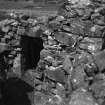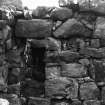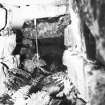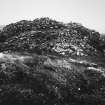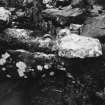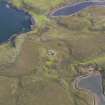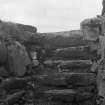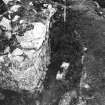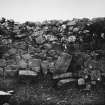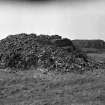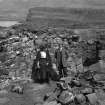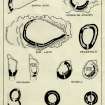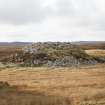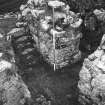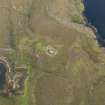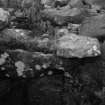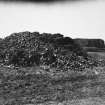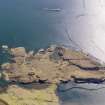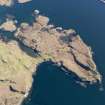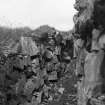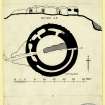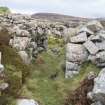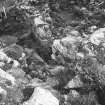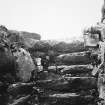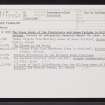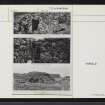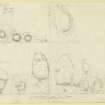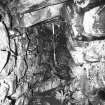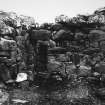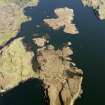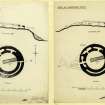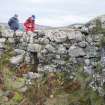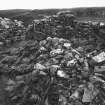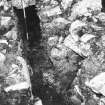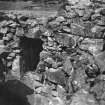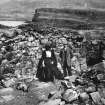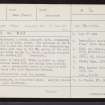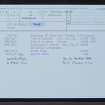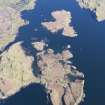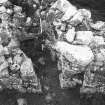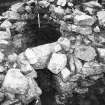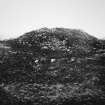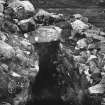Following the launch of trove.scot in February 2025 we are now planning the retiral of some of our webservices. Canmore will be switched off on 24th June 2025. Information about the closure can be found on the HES website: Retiral of HES web services | Historic Environment Scotland
Skye, Duirinish, Dun Fiadhairt
Broch (Iron Age)(Possible)
Site Name Skye, Duirinish, Dun Fiadhairt
Classification Broch (Iron Age)(Possible)
Alternative Name(s) Duirinish; Dun An Iarnhard
Canmore ID 10925
Site Number NG25SW 1
NGR NG 2314 5045
Datum OSGB36 - NGR
Permalink http://canmore.org.uk/site/10925
- Council Highland
- Parish Duirinish
- Former Region Highland
- Former District Skye And Lochalsh
- Former County Inverness-shire
NG25SW 1.00 2311 5042
NG25SW 1.01 terracotta figurine
(NG 2311 5042) Dun (NR)
OS 6" map, Inverness-shire, 2nd ed., (1904)
Dun Fiadhairt, a broch, measures 31ft internally within a wall up to 12ft thick. The entrance in the W is checked for a door and fitted with two communicating cells. Another cell lies in the NW sector of the wall, and the stair-lobby in the N, while a gallery occupies the E and S sectors (R W Feachem 1963).
Excavated in 1914 (F T Macleod 1915). Finds included an amber necklace, various beads with one dating from probably 2nd century AD., and a terra-cotta model of a bale of wool indicating trade links with Romanized Britain.
F T Macleod 1915; J Curle 1932; RCAHMS 1928; R W Feachem 1963.
Dun Fiadhairt, as described above. Largely cleared of debris; good condition.
Visited by OS (A C) 14 April 1961.
Roman terra-cotta object now in the National Museum of Antiquities of Scotland (NMAS).
A Robertson 1970.
Field Visit (13 June 1921)
Dun, Fiadhairt (Iardhard), Dunvegan.
On the peninsula of Fiadhairt, about 1 3/8 miles north-west of Dun vegan Castle, are the ruins of a broch, excavated by Countess Latour (1). It occupies the summit of a rocky knoll rising from some 12 to 25 feet above the surrounding ground, and stands rather lower than the generality of the rocky heights on the peninsula. It is about 50 feet above sea-level, some 50 yards north-east of a small arm of Loch Dunvegan, called Ob an Duin. (Fig. 229.)
The broch is circular, the internal diameter measuring 31 feet 6 inches, and the wall varies from 10 feet 6 inches to 12 feet in thickness. The outer face of the wall is for the greater part hidden by fallen stones, but, towards the east where it has been uncovered, it shows a height of 4 feet of masonry laid in irregular courses with a slight inward batter; the inner face shows an average height of about 6 feet, and a portion of a scarcement some 6 inches in width and about 6 feet 6 inches from the ground still remains on the left side of the main entrance, which is placed slightly south of west, and is approached by a roadway which curves up the rocky slope of the height, and is flanked on either side by a roughly built wall of later date for a distance of about 16 feet. The entrance is 3 feet wide at the outside and about2 feet 8 inches on the inside. Some 3 feet inwards is a door check on either side of the passage, and at 1 foot 1 inch nearer the interior on the north side is a doorway 3 feet 2 inches high and 1 foot 8 inches wide, with outer lintel in position, leading into an oval guard-chamber about 7 feet in length and from 3 feet to 4 feet in breadth (Fig. 227); on the south side, 1 foot 6 inches inwards from the check, is a doorway 1 foot 11 inches wide to another cell 6 feet 5 inches long and 4 feet broad with a recess at the south end 2 feet 6 inches high, 2 feet wide, and 1 foot 2 inches deep. The chambers and entrance passage are roofless. The entrance passages to these cells measure 14 inches in length on the south and 2 feet 4 inches on the north. In the interior some 13 feet 6 inches northwards from the entrance a complete doorway, 3 feet 6 inches high, 1 foot 8 inches wide, and 3 feet 10 inches long, leads into a roofless oval chamber, 17 feet long and from 3 feet 3 inches to 4 feet 2 inches wide, which is divided into two opposite the doorway by a buttress-like projection on the inner face 1 foot 7 inches broad and 9 inches deep; about 1 foot 9 inches from the floor in a corner of the southern end is a small recess 13 inches high and 10 inches broad on face, widening to 1 foot 10 inches inside and penetrating about 3 feet into the wall. About 14 feet from the entrance to this cell is another entrance 2 feet 6 inches wide and 3 feet 6 inches long, from which the lintel stones have been removed, leading into a chamber which extends westwards towards the last cell for a distance of 8 feet 10 inches, the breadth being from 3 feet 3 inches to 2 feet4 inches. The eastern end of this gallery on the right of its doorway contains the beginning of the staircase, of which six steps remain. Almost opposite the main entrance to the broch and 16 feet from the last doorway is an opening (Fig. 228) into a low and well preserved passage to the outside which is broken in the middle by the mouth of a gallery. The inside portion of this passage, on which three lintels remain, measures 4 feet 6 inches in height, 1 foot 7 inches in breadth, and 4 feet 8 inches in length, while the outer, with four lintel stones, measures 4 feet 5 inches in length,2 feet 11 inches in height, and 1 foot 11 inches in breadth. The gallery to which this doorway gives access is 2 feet wide and extends for a distance of 50 feet around the southern arc of the broch to within 3 feet of the chamber to the south of the main entrance. Immediately to the south of its entrance seven lintels covering a length of 7 feet 6 inches remain in position and farther on there are other two.
Built across the interior of the broch from the north side of the entrance to the long gallery to within 4 feet of the main entrance is a roughly built wall about 5 feet 6 inches thick and of an average height of about 3 feet. It is of late construction, and it is not bonded into the wall of the broch.
A necklace composed of fifty-nine discoid amber beads, and a considerable quantity of shards of hand-made pottery, were discovered.
RCAHMS 1928, visited 13 June 1921.
OS map: Skye xxi.
Publication Account (2007)
NG25 1 DUN FIADHAIRT (‘Dun Iardhard’)
NG/2311 5042 (GPS NG 2315 5044)
This is a slightly abnormal, probable ground-galleried broch in Duirinish, Skye, which was excavated in about 1892 by the Countess Vincent Baillet de Latour. F T MacLeod of the National Museum, who wrote the report, only saw the site after the work was completed (visited 22/4/63, 1971, 15/8/85 and 13/11/03). This situation contrasts with that of Dun Beag (NG33 3 below) where J G Callander seems to have visited the excavation several times as it progressed. In 1995 the Royal Commission obtained copies of some photographs taken during the excavations [13] and, since these are dated 1892, some or all of the work evidently took place during that year.
Description
The structure stands on a low, fairly steep-sided rocky knoll in the midst of now desolate moorland, and on the large peninsula which juts into the east side of Loch Dunvegan and is joined to the mainland by a low, narrow neck.
The outer wallface is mainly concealed by debris (presumably that thrown out of the interior during the excavations) but the visible masonry is in general of good quality, being made of rectangular blocks of metamorphic rock; it stands up to eight courses high in places. The main entrance is on the west side and steps lead up to it; piles of what is surely debris from the excavation lie on either side of the approach, giving the illusion of a later outwards extension to the passage. This passage is 3.66m (12 ft) long, 91cm (3 ft) wide at the outer end and 84cm (2 ft 9 in ) at the inner. The door-frame is about 91cm (3 ft) from the exterior and the checks are well-built rebates in the passage walls; the bar socket is in the left wall and the bar-hole (mainly blocked) in the right.
A short distance behind the checks are the doors to two opposing guard cells. The one on the left is a fine, corbelled oval chamber with the domed roof still rising about 1.83m (6 ft) above the floor; one lintel remains over the doorway. On the other hand the cell on the right is much cruder, measuring 1.86m (6 ft) by 1.30m (4 ft 3in); it is in fact the broadened end of the mural gallery behind, blocked off from the rest by a primary rear wall which abuts against the outer wall in a straight joint; thus only the inner wall of the cell is curved (see Dun Ardtreck – site NG33 2 below). This feature is not shown on the original site plan.
In the side of this blocking wall which faces the entrance is what looks like a short, thick lintel with a space below it; it gives the impression that there was a low opening from the cell to the gallery behind, but on the opposite side the masonry is now in too poor a state to judge if the opening came right through.
A fragment of the scarcement, of the ledge-type, is preserved on the inner wallface just to the left of, clockwise from, the entrance; it is 15cm (6in) wide and about 1.98m (6 ft 6in) above the ground. This feature is not so convincing now as when the author first saw it in 1963. At several points the inner face has been restored with one or two courses of crude masonry, presumably after the excavations.
Looking at the plan of the broch overall, the south-east half of Level 1 of the wall is occupied by a continuous mural gallery while the other half – from 5 to 11 o'clock – contains the entrance passage with its two guard cells, another dumb-bell-shaped mural cell at 8.30 o'clock and the stair with a long stair-foot guard cell, entered by a door at 10 o'clock.
The double mural cell at 8.30 o'clock is 5.26m (17 ft 3 in ) long by 1.37m (4.5 ft) wide and is shaped like a dumb-bell because of a curious masonry buttress projecting inwards from the outer wall opposite the doorway. There is an aumbry in its south-west end.
The stair-foot guard cell is 2.68m (8 ft 10in) long and only 1.0 – 0.71m (3 ft 3 in to 2 ft 4 in) wide; it is thus more of a length of mural gallery than a true wall chamber. Six steps of the mural stair were found during the excavations.
At 12 o'clock is the doorway to the mural gallery which runs clockwise from that point to join the inner end of the right guard cell. Although the Commission's plan shows the wall to the left of this door as solid the gallery actually runs to the left and probably finishes blind under the stair. While examining the left side of the doorway in 1963 the author caused the fall of some loose debris (left by the excavator) which disclosed the outer face of the gallery continuing to the left. Presumably the Commission surveyors – assuming that low door was a primary one – supposed that the left side of the doorway continued right across the wall (but see below). It may be assumed that this gallery extends to behind the stair.
The mural gallery has some stone lintels still in position, though doubtless fewer than when it was first exposed. It measures 1.37m (4.5 ft) in width at the lop and 15.48m (50 ft 9 in) in length, excluding the section to the left of the door. If the whole distance from the back of the base of the stair is hollow this section of gallery is about 70 ft 9 in (21.6m) long. In the southern arc there are a few traces of an upper gallery above the lintels of the lower [11].
The door to this gallery now goes right through the wall to form a second entrance and this seems to be a primary feature, there being a large lintel over its outer end (which is 76cm or 2.5 ft, wide) [3. fig. 228]. The doorway is only about 76cm (2.5 ft) high under the lintel. If this small entrance really is part of the original broch architecture it makes Dun Fiadhairt unique. A crude secondary wall was found running across the interior, from 0.9-1.5m (3-5 ft) thick.
The excavations of 1892
Little clear information about the stratigraphy inside the broch was obtained by Mr MacLeod; no doubt the need for an improved technique of excavation was pointed out to the Countess by the National Museum archaeologists and resulted in her excavating Dun Beag with more care. According to MacLeod the method of excavation adopted by the Countess at Dun Fiadhairt was to locate an inner wallface and work along it, sifting all soil removed through the fingers. It is known to have been a fine, dry summer from accounts of the onset of the First World War. In fact this was an improvement on most other Scottish excavations carried out at that time and is doubtless the reason that so many small objects were found.
Structural analysis
The signs of an upper gallery in the southern sector show that Dun Fiadhairt is a true hollow-walled broch. Its ground plan (Level 1) however is unusual in that most of the sector from 5-10 o'clock is occupied by guard cells, entrance passage, double cell and stair-foot guard cell with stair [12, plan]. The rest of the circuit is occupied by a ground level gallery which appears to run back to the rear of the stair, as at Dun Mor Vaul (NM04 4). In the author's original classification the site would be termed a transitional broch (half way between ground-galleried and solid-based) but this implies that Dun Fiadhairt somehow stands apart from its neighbours on Skye, which it does not do in any meaningful way. To all intents and purposes it is a ground-galleried broch.
The one puzzling feature is the narrow and low second entrance at 12 o'clock. If this site is considered alone the passage can be interpreted as primary; there are no obvious signs of the outer part of the passage being secondary. However all the other second entrances found in brochs appear to be of later construction, most probably inserted a fter the upper parts of the towers had been pulled down, and this does seem the most likely explanation for the eastern passage at Dun Fiadhairt. It would have been much easier to insert the lintel in the outer face if the latter was only 1.8-2.1m (6-7 ft) high than when it was 10.7m (35 ft). The floor of this passage appears to be raised above the level of the central court but it is possible that not all the rubble has been cleared out of it.
Cultural contacts
The clay model of a bale of wool, thought to be Roman (below), is an unique find and demands some explanation [2, fig. 11]. Normally one would assume that Roman finds on Iron Age sites in the Western Isles had come from Roman-occupied southern Scotland in either the late 1st or the mid 2nd centuries AD and that they drifted out there by means of exchanges between Iron Age tribesmen. There is however a possibility of direct contact on one occasion in the late AD 70s between at least one site on Skye and an exploring Roman fleet (discussed in the entry on Dun Ardtreck-NG33 1), and the object might be better explained in this way.
Finds [2]
The only metal found was a large quantity of “iron refuse” and some fragments of “iron bolts”: there was no bronze.
Stone objects included 1 rotary quern, 1 whetstone, 3 rubbing stones, 3 sandstone whorls (1 being decorated with incised lines on one face and a concentric incised circle on the other), 2 oval quartzite pebbles with iron-stained grooves, presumably strike-a-lights, 1 quartzite hammerstone and 1 fragment of a steatite armlet; 3 flint scrapers were also found.
Glass and amber objects included 3 spheroid beads of translucent green glass, 1 fawn-coloured with a spiral pattern, 1 fragment of a fat ring bead of black glass with blue and yellow streaks twisted round it and 1 small yellow ring-bead; there were also 2 beads of reddish opaque glass shaped like double-truncated cones (possibly Anglo-Saxon) [2, fig. 10]. In addition there were also 59 amber beads in the form of short cylinders which can make a necklace 26.0cm (10.25 in) long when strung [2, fig. 9]. Forty-eight of them were under a hollowed slab in the doorway to the dumb-bell-shaped mural chamber and 11 more were in the clay of a hearth in the same cell.
Fired clay: a quantity of Iron Age pottery was found, much of it at the foot of the staircase. The rim sherds include several vases with geometrical incised decoration closely similar to the Vaul ware found on Tiree (site NM04 4); there are also two with curvilinear channelled decoration similar to that on the Everted Rim ware from the same site.
Roman: there was also found a baked clay object, deduced to be a Roman votivc model of a bale of wool [4, 6 and 7].
Animal bones: a very brief report on this is appended to the report [2, 70].
Dimensions
The external diameter was given as 55 ft (16.78m), the internal as 31.5 ft (9.61m); the walls were from 10.5 ft to 12 ft (3.20m -3.66m) thick [3] so the wall proportion would be c. 42.5%. In 1971 the shape of the central court was accurately planned and it proved to be close to a true circle with a radius of 4.76 +/- 0.09 m; the mean diameter is thus 9.52m (31.2 ft), very close to the original measurement.
Sources: 1.. NMRS site no. NG 25 SW 1: 2. MacLeod 1915: 3. RCAHMS 1928, 57-70, no. 508 and figs. 227-29: 4. J Curle 1932, 349: 5. Feachem 1976, 171-72: 6. A Robertson 1970, Table 2: 7. Mann 1974, 35-6, 1975, 31, no. 40: 8. MacKie 1975, 167: 9. Guido 1978, 195 and 200: 10. Green 1978, 59: 11. Swanson (ms) 1985, 859-62 and plan: 12. MacSween 1984-85, 42, no. 10, fig. 10 and pls. 6 and 7: 13. Discovery and Excavation in Scotland 1995, 123.
E W MacKie 2007





















































